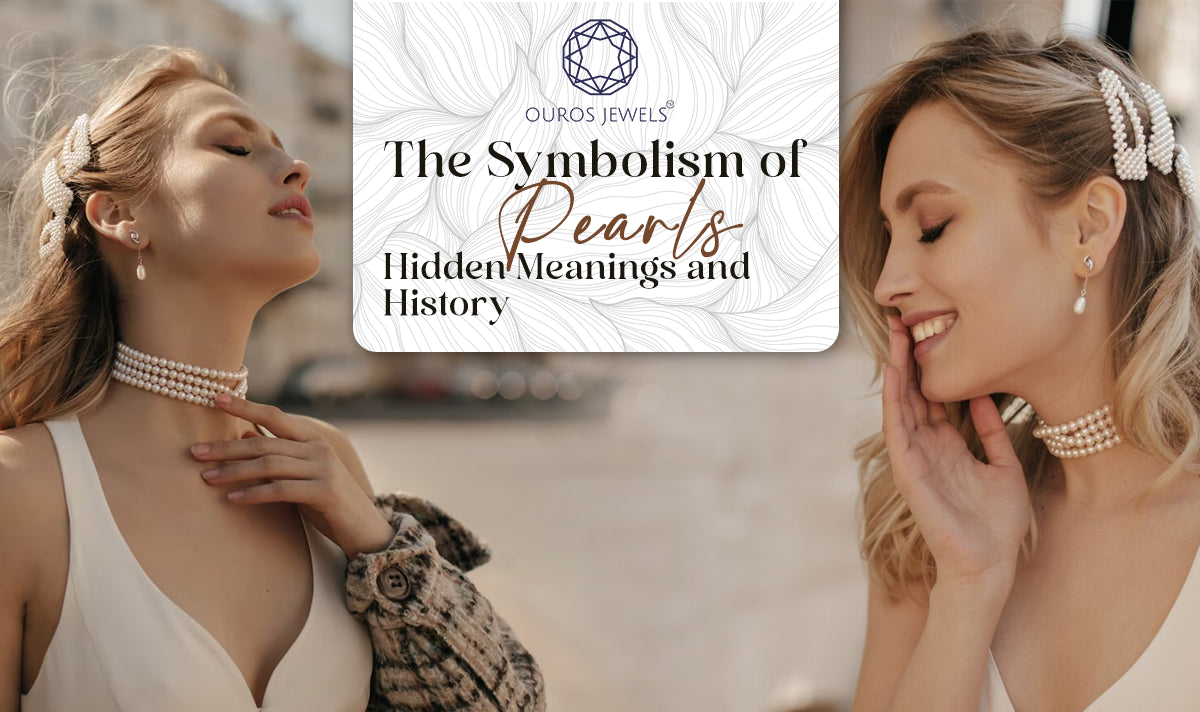

The Symbolism of Pearls: Hidden Meanings and History

Pearls have fascinated people for centuries, symbolizing purity, wisdom, wealth, and status in many cultures. More than just beautiful gems, their creation where a mollusk forms a pearl around an irritant represents turning challenges into something valuable.
In different cultures, pearls symbolize various things: the purity of a bride, the tears of gods, or spiritual growth. Unique among gemstones, pearls form within living creatures, adding to their natural beauty and serenity. Today, pearls still inspire and hold significant meaning in fashion, art, and philosophy, connecting nature, culture, and personal style.
Table Of Content⮟
Historical Significance of Pearls
![[Close-up of a pearl necklace draped over a satin glove with text: 'Historical Significance of Pearls' on a vintage background.]-[ouros jewels]](https://cdn.shopify.com/s/files/1/0527/7669/8040/files/Historical_Significance_of_Pearls_600x600.webp?v=1721308043)
Throughout history, pearls have been cherished for their beauty and symbolism. In Ancient Rome, they were a mark of wealth and power. Greeks associated them with love and marriage, believing pearls would bring happiness to newlyweds. In Chinese culture, pearls symbolize wisdom and protection, often seen as a defense against evil spirits.
How Pearls Form: Nature’s Miracle
Pearls form when an irritant, like a grain of sand, enters an oyster or mollusk. The creature secretes layers of nacre around the irritant, creating a pearl. There are two main types:
- Natural Pearls: Formed without human intervention, these are rare and often irregular in shape, making them highly valuable.
- Cultured Pearls: Created in controlled environments where an irritant is purposely inserted into the mollusk, these pearls are more common and affordable, yet still beautiful.
-
Types of Pearls: Natural vs. Cultured
| Characteristic | Natural Pearls | Cultured Pearls |
|---|---|---|
| Formation | Form naturally in oysters or mollusks without human help. | Created by inserting an irritant into an oyster to start pearl formation. |
| Occurrence | Rare and found in the wild, becoming scarce. | Produced in pearl farms, available in various sizes and shapes. |
| Shape and Size | Varied and often irregular shapes and sizes. | Can be made in uniform shapes and sizes to meet demand. |
| Cost | More expensive due to rarity and natural formation. | More affordable, as they are farmed and readily available. |
| Nacre Quality | High-quality nacre with unique luster. | Quality varies, but farming techniques have improved nacre quality. |
| Market Availability | Limited, seen as collector’s items. | Widely available in jewelry stores and markets. |
| Environmental Impact | Harvesting can harm natural populations and ecosystems. | More sustainable and eco-friendly, with less environmental damage. |
-
Properties of Pearls
- Luster: The shine or glow on the pearl's surface.
- Surface Quality: The smoothness and cleanliness of the pearl’s exterior.
- Shape: Varies from round to baroque and irregular shapes.
- Size: Measured in millimeters, ranging from small seed pearls to large South Sea pearls.
- Color: Includes white, cream, pink, black, gold, and more.
- Nacre Thickness: Contributes to the durability and quality of the pearl.
Pearl Symbolism and Metaphysical Qualities
Pearls symbolize purity, wisdom, and calmness. They are often associated with emotional balance and are believed to promote personal growth. Different cultures attribute various meanings to pearls:
- White Pearls: Represent purity, innocence, and new beginnings.
- Black Pearls: Symbolize strength, resilience, and mystery.
- Pink Pearls: Associated with love, compassion, and femininity.
- Gold Pearls: Represent prosperity, success, and achievement.
- Blue Pearls: Reflect tranquility, truth, and calmness.
Pearls in Fashion and Jewelry
![[Portrait of a woman wearing a pearl necklace and earrings, holding a pink flower, with text: 'Pearls in Fashion and Jewelry' on a vintage-themed background.]-[ouros jewels]](https://cdn.shopify.com/s/files/1/0527/7669/8040/files/Pearls_in_Fashion_and_Jewelry_600x600.webp?v=1721308158)
Pearls are timeless and add elegance to any outfit, whether casual or formal. They are perfect for rings, necklaces, earrings, and bracelets. Available in colors like white, cream, black, pink, and gold, pearls can be used to create unique and personalized jewelry.
Pearl rings often feature the gem as the main focus, sometimes paired with diamonds for added sparkle. Pearl necklaces can be simple or layered for a bold statement. Pearl earrings, whether studs or drop styles, always add a touch of class.
Pearls come in various shapes, from round to irregular, offering many customization options. This variety makes pearl jewelry suitable for any occasion, from daily wear to special events like weddings.
Pearls symbolize purity, wisdom, and wealth, making them meaningful gifts and treasured heirlooms. Whether for their beauty or symbolism, pearls remain a symbol of elegance and refined taste.
How to Care for Your Pearls
To keep your pearls looking their best, it’s important to follow some simple care steps. After wearing, gently clean your pearls with a soft, damp cloth to remove any oils or residue. For storage, place them in a soft pouch or a separate compartment in your jewelry box to prevent scratches and damage from other pieces. This routine will help preserve their natural luster and beauty for years to come.
Also You read
Conclusion: The Beauty and Meaning of Pearls
Pearls symbolize purity, wisdom, and resilience. Treasured for centuries, they represent love, protection, and elegance. Whether natural or cultured, pearls form within living creatures, adding unique significance to their beauty.
With various colors and shapes, pearls are perfect for any occasion. Proper care keeps them lustrous and elegant. Embrace the timeless charm and deep meanings of pearls in your jewelry, showcasing grace and sophistication.
FAQs: Symbolism of Pearls
Q.1 What do pearls symbolize?
Ans. Pearls symbolize purity, wisdom, and calmness. They are also linked to wealth and status in many cultures.
Q2. What are the metaphysical properties of pearls?
Ans. Pearls are believed to promote emotional balance, support personal growth, and have healing properties. They are also associated with feminine energy and grounding.
Q.3 How do different cultures view the symbolism of pearls?
Ans. In Korean culture, pearls symbolize prosperity and good luck. In Vietnamese culture, they represent happiness and harmony. Middle Eastern cultures see pearls as symbols of power and royalty, while Western traditions often associate them with purity and spiritual growth.
Q.4 What do different pearl colors symbolize?
Ans. White pearls symbolize purity and innocence. Pink pearls represent love and romance. Black pearls signify strength and resilience, while gold pearls denote prosperity and success.
Q.5 How are pearls formed?
Ans. Pearls form inside oysters or mollusks when an irritant enters the shell. The creature secretes layers of nacre around the irritant, gradually forming a pearl. This process can happen naturally or be initiated by humans in cultured pearls.
Q.6 What is the historical significance of pearls?
Ans. Historically, pearls have been valued for their beauty and rarity. They symbolized status and wealth in Ancient Rome, were associated with love and marriage in Greek culture, and were believed to offer protection and wisdom in Chinese traditions.
Q.7 What is the rarest color of pearl?
Ans. Natural blue pearls are the rarest in the world.
Q.8 What are the benefits of wearing pearls?
Ans. Wearing pearls is believed to bring peace, courage, confidence, and calmness. They are also thought to help with emotional balance and spiritual growth.
Q.9 How should pearls be cared for?
Ans. Pearls should be wiped with a soft, damp cloth after wearing and stored in a soft pouch or separate compartment to avoid scratches. Avoid exposing pearls to water and direct sunlight for long periods.
Q.10 What is the significance of pearls in fashion?
Ans. Pearls are timeless and versatile in fashion, adding elegance to any outfit. They are popular in various jewelry pieces such as rings, necklaces, earrings, and bracelets, symbolizing purity, sophistication, and refined taste.
Recent Blogs
-
July 19, 2025
-
June 19, 2025
-
May 6, 2025
-
April 22, 2025
-
November 28, 2024

 Solitaire Rings
Solitaire Rings

 Halo Rings
Halo Rings

 Bezel Rings
Bezel Rings

 Three Stone Rings
Three Stone Rings

 Five Stone Rings
Five Stone Rings

 Bridal Set Rings
Bridal Set Rings

 Solitaire Accent Rings
Solitaire Accent Rings

 Toi Moi Rings
Toi Moi Rings

 Semi Mount Rings
Semi Mount Rings

 Custom Rings
Custom Rings

 Color Diamond Rings
Color Diamond Rings

 Lab Gemstone Rings
Lab Gemstone Rings

 Men's Rings
Men's Rings

 Round
Round

 Pear
Pear

 Oval
Oval

 Princess
Princess

 Asscher
Asscher

 Marquise
Marquise

 Emerald
Emerald

 Cushion
Cushion

 Radiant
Radiant

 Heart
Heart

 Old Cuts
Old Cuts

 Eternity Bands
Eternity Bands

 Dainty Bands
Dainty Bands

 Custom Bands
Custom Bands

 Men’s Bands
Men’s Bands

 Studs
Studs

 Hoops
Hoops

 Jackets
Jackets

 Dangle
Dangle

 Bridal
Bridal

 Tennis Bracelet
Tennis Bracelet

 Fashion Bracelet
Fashion Bracelet

 Pendant
Pendant

 Necklace
Necklace

 Men's Jewelry
Men's Jewelry

 Pink
Pink

 Champagne
Champagne

 Yellow
Yellow

 Blue
Blue

 Black
Black

 Green
Green

 Olive
Olive

 Ruby
Ruby

 Sapphire
Sapphire

 Other Gemstone
Other Gemstone

 Old Cut Jewelry
Old Cut Jewelry

 Antique Diamond Jewelry
Antique Diamond Jewelry

 Kids Collection
Kids Collection

 Celebrity Jewelry
Celebrity Jewelry

 Old Cut
Old Cut

 Antique Cut
Antique Cut

 Matching Pair
Matching Pair

 Step Cut
Step Cut

 Rose Cut
Rose Cut

 Portuguese Cut
Portuguese Cut

 Portrait Cut
Portrait Cut

 Pie Cut
Pie Cut

 Champange
Champange

 Other
Other

 IGI-GIA Certified
IGI-GIA Certified

 8X Diamond
8X Diamond

 Ready Stocks
Ready Stocks

 OEC Round
OEC Round

 Old Mine Cushion
Old Mine Cushion

 Old Mine Moval
Old Mine Moval

 Old Mine Emerald
Old Mine Emerald

 Old Mine Asscher
Old Mine Asscher

 Old Mine Pear
Old Mine Pear

 Old Mine Heart
Old Mine Heart

 Rings
Rings

 Bands
Bands

 Earrings
Earrings

 Bracelets
Bracelets

 Anniversary Gift
Anniversary Gift

 Birthday Gift
Birthday Gift

 Gift For Her
Gift For Her

 Gift For Him
Gift For Him

 Under 300$
Under 300$

 Under 500$
Under 500$







